Analyzing the cornucopia of law enforcement rotary- and fixed-wing platforms
By Jay Chandler
Contributing Writer
The first use of aviation assets in law enforcement (LE) dates back to 1948, when Bell delivered a Bell 47D to the New York City Police Department, according to a White Paper entitled Airborne Public Safety: Worth the Investment, published by Bell earlier this year.
From that one helicopter, aircraft use in public safety has grown to multi-platform aviation units, which today include helicopters, airplanes, and unmanned aerial systems. And certainly in the near future there will be eVTOL aircraft.
Each platform holds distinct advantages over the other, depending on its intended use. Rotary-wing aircraft have the upper hand for rappelling, fast rope ops, hoisting, maintaining contact in a stationary hover, or providing overwatch for officers on the ground. Airplanes, on the other hand, cost less per hour and are quieter, so the suspect may be unaware of the presence of fixed-wing surveillance teams.
Airplanes may also be tasked with prisoner transport or with speeding enforcement. As budgets decrease and aircraft become more complicated and expensive, LE agencies must be on board with the organization’s mission, whether it is LE, emergency medical service (EMS), search-and-rescue (SAR), or a combination of the 3.
Multirole or strictly public safety
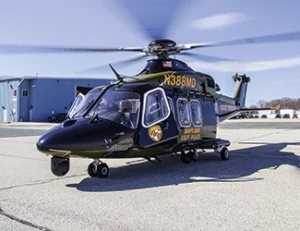
Los Angeles Police Department’s Air Support Division leadership is very clear that its mission is LE only, whereas the Maryland State Police (MSP) uses its Leonardo AW139 helicopters in the dual role of LE and medevac services.
With its assigned mission of EMS, MSP chose a slightly larger multi-engine helicopter than most public safety aircraft operators do, and thus gained more internal space for litters and increased power for hoist operations.
Based on funding mandates of the State of Maryland, responses must be 80% EMS/SAR and 20% public safety.
As with any aircraft acquisition, many factors dictate aircraft selection, such as size of area of operation, required role, day/night ops, special equipment (eg, NVGs), and the inescapable funding equation. Smaller helicopters like the Airbus H125, MD 530F, or Robinson R66 perform well in patrol mode, requiring a smaller budget than the Leonardo AW139.
Regardless of size, standard equipment for public safety aircraft includes illumination and high-definition cameras with infrared capability. Modern sensors on these aircraft are normally capable of slewing to a geographic point and keeping the cameras focused on the subject regardless of where the aircraft is facing.
Increased payload capacity allows for a more robust sensor package, with displays in the cabin for observers to run the mission, freeing up the pilot to maintain proper situational awareness.
Bell
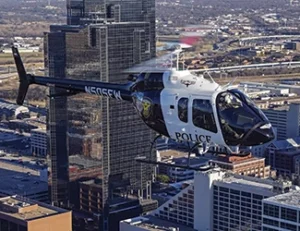
Bell was the first helicopter manufacturer to enter the public safety arena with the 47D – a 200-hp, 880-lb useful load helicopter, adequate for 2 slender officers and a moderate amount of fuel.
But rapid advances were made by all OEMs to provide the wide assortment of mission-ready helicopters we know today.
The Bell 505 Jet Ranger X is a lightweight single-engine helo with a Garmin G1000H flight deck.
The Bell 407GXP can carry out command-and-control missions with microwave downlink, and also has tactical insertion capabilities.
Powered by the Rolls-Royce 250-C47B/8 engine, the 407GXP delivers excellent hot-and-high performance.
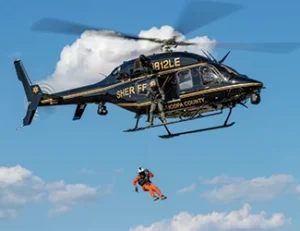
For increased performance and safety, the twin-engine Bell 429 has large doors for tactical ops, and a cruise speed faster than many single-engine airplanes.
It’s easily configurable for tactical insertions or hoist missions due to its exceptional hover performance at 11,290 ft.
For even more demanding public safety missions, the Bell 412EPX twin-engine helicopter brings more room and more power for the multirole mission many aviation units crave.
Little birds: Robinson and MD
The lightest helicopter serving in the LE role is the Robinson R66 police helicopter.
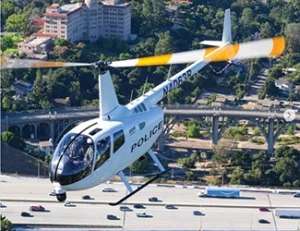
Although many models of the Robinson helicopter have served public safety mission roles, the R66 Police helicopter is a turbine-powered public safety platform whose nose tip houses an Ultra 8000 thermal imaging camera system from FLIR Systems, offering a high degree of infrared detection.
It integrates an infrared camera with 10X optical zoom, plus a daylight camera with an 18X optical zoom.
MD Helicopters continues to provide nimble and responsive tactical helicopters for patrol and tactical insertion missions. The MD 530F is a robust version of the famous MH-6 Little Bird operated by the 160th Special Operations Aviation Regiment on missions such as special ops forces insertions onto rooftops or on narrow roadways – quite similar to SWAT teams today.
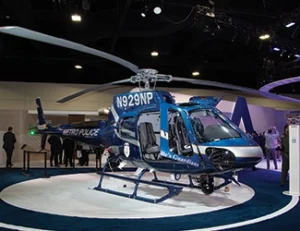
Airbus
Airbus Helicopters continues to offer a wide selection of workhorse aircraft, from the light single-engine H125 all the way up to the beefy H225 Super Puma.
In June 2024, Airbus secured an order for up to 44 H225s for the German Ministry of Interior Federal Police, signaling complete confidence in the helicopter’s ability to leverage its payload, range, advanced systems, and versatility for all LE and homeland security missions for Germany.
Many Airbus helicopters continue to serve in the LE role, like the Eurocopter AS350B (now Airbus H125) operated by the Alaska Department of Public Safety.
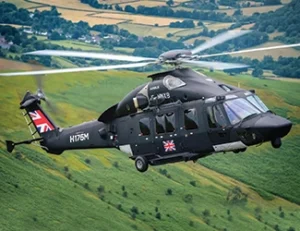
The AS365 Dauphin continues to be used by the United States Coast Guard for drug interdiction, and by public service agencies around the world, such as the Victoria Police in Australia.
Airbus continues to innovate with the H175 twin-engine multirole helicopter, which has been in service since 2015, with a large cabin, extra-large windows, and multi-engine reliability.
Leonardo
Many hard-working helicopters serving communities in LE guise are made by Leonardo. Single-engine helicopters like the AW09 and AW119Kx bring lightweight helicopter service for patrols, while the twin-engine AW109 Trekker is more of a utility design.
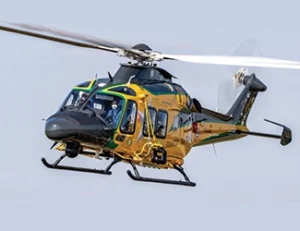
For a more vigorous group of helicopters serving agencies that need more power, more room, and more speed, the AW139, AW169, and AW189 platforms bring versatility for demanding public safety operations, as well as SAR and EMS capabilities to operators around the world.
Sikorsky
Any discussion of helicopter capabilities and performance can’t take place without the company that brought the first operational helicopter to the world – Sikorsky.
The company has come a long way from the R-4 and the variants of the UH-60 Black Hawk that have served well in military and LE agencies around the world.
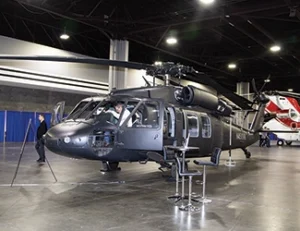
Fixed-wing operations
Airplanes have been serving in LE agencies for decades. Although they are not always captured on TV rescuing survivors from rooftops, they certainly save the day, too.
Many public safety agencies, like the New Hampshire State Police (NHSP), use a mix of fixed- and rotary-wing aircraft. NHSP flies a Cessna 182T as well as a Bell 407, and uses the Cessna 182 for assistance in the areas of criminal surveillance, searches for missing and wanted individuals, aerial photography, and speeding enforcement.
Smaller fixed-wing aircraft may not even have a radio or additional equipment, while others are fitted for aerial electronic surveillance with multi-sensor cameras and infrared imagery displayed at the observer station like the Air Bear customized Cessna T206H.
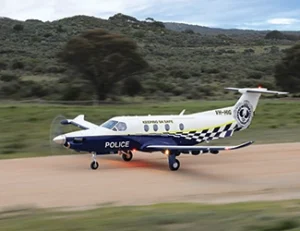
The Partenavia P68B Observer is a special-mission version of the P68 twin, with larger fuel tanks allowing long loiter times, and a transparent nose section providing excellent visibility.
New equipment is now being installed on general aviation aircraft, such as the Beechcraft Baron G58, Daher Kodiak 100, and the Tecnam P2012, which provide excellent stable platforms for aerial surveillance.
Pilatus has moved forward with a version of the PC-12 Spectre developed for intelligence, surveillance, and reconaisance (ISR) work, complete with displays and multi-sensor surveillance gear.
Conclusion
LE agencies must define their mission to determine the appropriate aircraft to accomplish those tasks. Mountainous versus non-mountainous regions certainly dictate aircraft requirements. Moreover, budget constraints certainly narrow the equipment needs.
Whether helicopters or airplanes are needed, one thing is sure: The choices are vast, and aircraft manufacturers offer quality equipment for the task.
 Jay Chandler has written for Pro Pilot since 1995, and has flown for FAA, military, and Part 91 and 135 operators throughout his 30-year career.
Jay Chandler has written for Pro Pilot since 1995, and has flown for FAA, military, and Part 91 and 135 operators throughout his 30-year career.